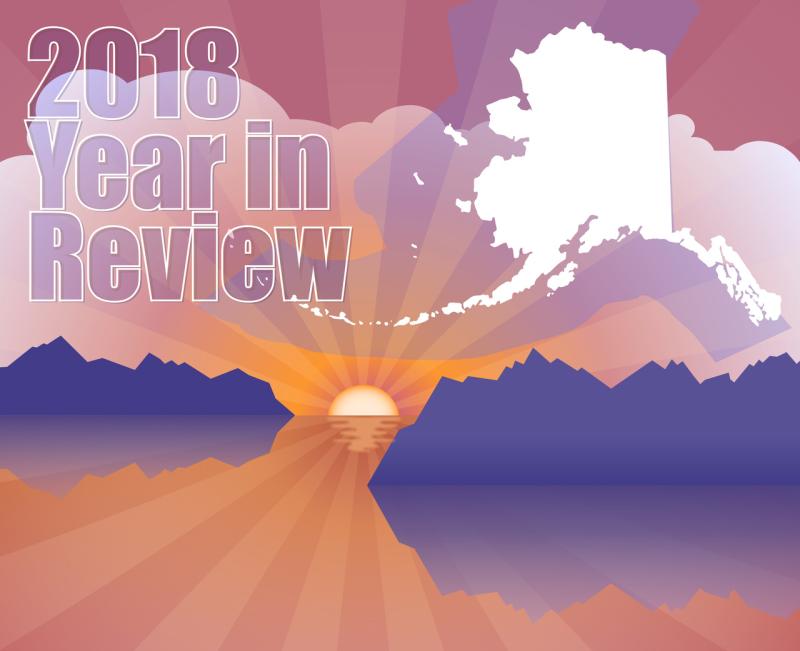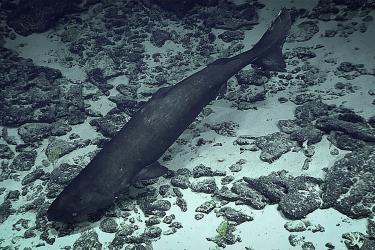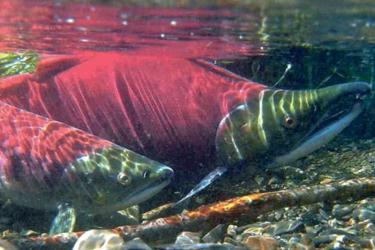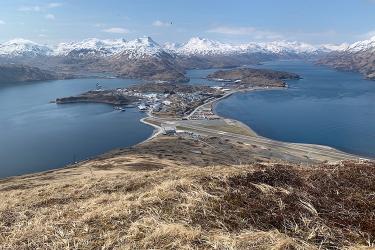Ensuring Sustainable Fisheries
More fish come through the Alaska fishing port of Dutch Harbor than anywhere else in the Nation. In fact, Dutch Harbor and Kodiak, Alaska, are the top two U.S. fishing ports in landed volume. These same two ports rank No. 2 and No. 3 in U.S. economic value.
We collect biological, ecological, and environmental data during long-term, standardized research surveys, from fishing catches, and through other research activities. In the laboratory and in the field we study what fish and crabs eat, where they live, and how fast they grow. We input these data into sophisticated computer models to generate estimates of fish abundance (number of fish in the population), determine the potential impacts of environmental change, and recommend sustainable fishing limits. We also collect socio-economic data on fisheries and coastal communities, and other ecosystem data. Resource managers use this information to develop sound management measures ensuring healthy fisheries over the long term with ecological, economic, and socio-cultural benefits for the nation.
Our primary responsibility is to provide scientific data, analyses, and expert technical advice to marine resource managers (i.e., the NOAA Fisheries’ Alaska Regional Office, the North Pacific Fishery Management Council, the State of Alaska, the International Pacific Halibut Commission, and the Pacific Salmon Commission), Alaska tribal governments, public stakeholders, and U.S. representatives participating in international fishery and marine mammal negotiations. The work of monitoring and assessing fish, crab, and marine mammal populations, fisheries, and marine ecosystems is mandated by legislation, which includes the Magnuson-Stevens Fishery Conservation and Management Act, the Marine Mammal Protection Act, the U.S Endangered Species Act, and the National Environmental Policy Act.
Alaska fisheries are among the most well-managed and profitable fisheries in the world. This is due in part to good science and strong working relationships with the fishing industry and other stakeholders. Commercial and recreational fishermen, fish processing and retail businesses, resource managers, coastal communities, and Alaska Native subsistence communities all depend on the data and information we provide.

The Alaska Fisheries Science Center has a continuing history of dedicated research surveys. We conduct these surveys in the same areas and in the same way every year or every other year. As a result, we are able to determine status and trends of individual fish and crab populations, and ecosystems. We provide survey biomass estimates, enhanced data and ecosystem information for population assessment models, information on the impact of climate on populations and ecosystems, and information on essential fish habitat to aid in the effective management of Alaska marine resources. This year, we conducted 18 research surveys to collect biological and other information on groundfish, crabs, and other species.
Providing Scientific Advice for Management
We conducted 54 groundfish and crab stock assessments for 30 stocks in the Bering Sea and 24 stocks in the Gulf of the Alaska. Our staff had leadership roles (chair or co-chair) on important science bodies supporting Alaska fisheries management (Gulf of Alaska and Bering Sea/Aleutian Islands Groundfish Plan Teams, Crab Plan Team, Fishery Ecosystem Plan Team, Science and Statistical Committee, Integrated Ecosystem Assessment working group, Social Science Plan Team). Our science provides a basis for setting total allowable catch limits and preventing overfishing for fisheries in the North Pacific.
One Step Closer to Ecosystem-Based Fishery Management in Alaska
The Alaska Fisheries Science Center staff are helping the North Pacific Fishery Management Council to implement Ecosystem-Based Fishery Management in Alaska. In 2018, center scientists participated in a day-long ecosystem workshop and supported the development of the Council’s first Ecosystem Fishery Management Plan.
For more than 20 years, with input from academic, private sector, and government research partners, we have produced ecosystem status reports for the Bering Sea, Aleutian Islands, Gulf of Alaska, and Arctic. We track how various components of the ecosystem are doing to better understand ecosystem function and health.
Through projects like the Alaska Integrated Modeling Project (ACLIM) and other efforts, we model how various ecosystem components may be affected in the future by changes in climate, ocean acidification, and loss of sea ice. Fishery managers use this information to protect the long-term viability of fish and other marine resources, and the communities that rely on those resources. Center staff also collaborate and provide leadership in other efforts to advance Ecosystem-based Fishery Management including development of the Ecosystem Socio-economic Profiles, participation and chairmanship of the newly established Social Science Plan Team, and development of the multi-species CEATTLE stock assessment model.
Collecting Oral Histories in Rural Alaska
The Alaska Fisheries Science Center connected in new ways with rural Alaskans by visiting nearly a dozen communities to collect oral histories this year. We also hosted a series of workshops to look at the impacts of fisheries management and the socioeconomic conditions in Alaska’s fisheries and fishing communities. Scientists are also exploring how fishing families and the roles of women in Alaska’s fisheries may evolve with marketing innovations, strategic intergenerational networks, and regulatory frameworks. This effort will document how generations of families adapt when management programs are implemented including limited entry and catch share programs, and now the decreasing abundance of certain key fish stocks.
Eyes on the Water: The Work of Fisheries Observers
In 2018, 423 observers were deployed for 41,530 days in the Bering Sea, Aleutian Islands, and Gulf of Alaska, representing nearly half of all sea days observed in the U.S. Observers collected data on board 408 catcher processors, motherships, and catcher vessels, and at seven fish seafood processing plants in Alaska. In addition to fisheries data collections, observers record essential information on protected resources including Steller sea lions, killer whales, harbor porpoise, and the endangered short-tailed albatross. These data, along with research survey data and socio-economic and ecosystem data, are used to determine sustainable catch limits each year.
Keeping Observers Safe at Sea
Observer safety remains a top priority for Alaska Fisheries Science Center. Independent observers are trained regularly and placed on fishing vessels to collect a variety of biological and ecosystem data. This year 129 observer training classes were conducted. In 2018 an independent review of NOAA Fisheries observer programs agency-wide was conducted. In response, the Center refined observer safety training protocols to, among other things, incorporate hands-on, fire-fighting simulations to help observers better prepare in the event of a commercial fishing vessel fire at sea.
Biennial International Fisheries Observer and Monitoring Conference
Observer Program staff contributed their expertise through posters, oral presentations, workshops, and hands-on demonstrations during the 9th International Fisheries Observer and Monitoring Conference this past June. Over 300 researchers, observers, policy makers, researchers, and companies gathered in the fishing port of Vigo, Spain, to share and discuss emerging monitoring technologies and fishery-dependent data collection.
Protected Species
From California to the Arctic Ocean, we study the ecology, behavior, life history, and population dynamics of whales, seals, porpoises, and sea lions. Our scientists conduct surveys from air, land, and sea using innovative technologies such as an uncrewed aerial systems and remote cameras to collect images and biological information. They use sophisticated acoustic and satellite tracking technologies to listen for, find, and collect data on whales, seals, and sea lions. The goal of this work is to increase scientific understanding of how these populations are doing and to ensure their protection under the U.S. Marine Mammal Protection Act and the Endangered Species Act.

As part of NOAA Fisheries’ Species in the Spotlight initiative, the Alaska Fisheries Science Center began several new studies on endangered Cook Inlet beluga whales in Alaska. In 2018 the Center continued interdisciplinary, collaborative efforts with the Woods Hole Oceanographic Institution to examine the health of this population (e.g., explore pregnancy rates, sexual maturity, and use genetic methods to study skin disease, age, and kinship/relatedness). The Center is also collaborating with Alaska Department of Fish and Game and NOAA’s Southwest Fisheries Science Center, using a drone (a hexacopter) to photograph and measure whales to identify newborn calves based on body length. With this information the Center hopes to develop an annual estimate of calf production, and determine belugas’ reproductive health. In 2018, over 7,500 aerial photographs of belugas were taken. The Center also is working with the Mystic Aquarium and the Alaska Department of Fish and Game to study the effects of anthropogenic noise (i.e., pile driving and vessel noise). Even at levels well below regulatory acoustic exposure thresholds for belugas, noise has the potential to compromise vital functions such as feeding.
Collaborative Surveys to Help Understand Why the Western Steller Sea Lion Population Isn’t Recovering
This past year, scientists carried out a comprehensive survey to collect photographs and visual counts of endangered western Steller sea lions to update abundance trends. The effort entailed augmenting traditional aerial surveys in the eastern portion of the Aleutian Islands and the western Gulf of Alaska. Visual counts were made via ships, airplanes, and drones in collaboration with the U.S. Fish and Wildlife Service. Annual Steller sea lion abundance surveys are essential for monitoring the endangered western population in Alaska. This population began to decline in the mid-1970s, with the steepest declines occurring in the mid-1980s. The eastern portion of the population began to rebound in 2002. However, from 2015 to 2017 we observed unexpected declines in pup abundance in the eastern and central Gulf of Alaska regions (33% and 18%, respectively).
Scientists and Alaska Native Communities Partner to Study Remote Harbor Seal Population
In the Summer/Fall of 2018, the Aleut Community of St. Paul Island Tribal Government, the Duke University Marine Robotics and Remote Sensing Laboratory, and the Alaska Fisheries Science Center, with funding from the NOAA Uncrewed Aerial Systems (UAS) Program, began a collaborative research project to obtain critical new estimates of harbor seals in the Pribilof Islands. This small, isolated population of harbor seals has been historically under-surveyed. Harbor seals have been an important subsistence resource to the Aleut community since the Pribilof Islands were permanently settled in the late 1700s. Study areas on the islands were chosen based on historical observations and traditional knowledge from hunters and residents of St. Paul and St. George. Land- and boat-based UAS surveys were conducted on and around three islands. The two main objectives were to conduct a comprehensive survey and to explore the use of advanced drone platforms for future, community-led monitoring. This collaborative effort represents the first comprehensive harbor seal survey conducted in the Pribilof Islands and the first step in developing a long-term monitoring and data collection program.
Innovative Science: Technology Enhancement and International Prestige
We are always looking for more efficient ways to explore the ocean environment. We seek to understand trends in abundance of marine life, identify their habitats, and monitor fish catches. We collaborate with fishermen, engineering companies, and academic institutions to design and test new technologies and identify better, more cost-effective methods for gathering data. Through these efforts, some of which are highlighted below, we are also able to explore areas of the ocean that are difficult to survey using traditional research methods.

NOAA Fisheries is exploring the wide-scale application of an innovative method for determining the age of fish that is now used by the Alaska Fisheries Science Center. The Center is using Fourier transform near-infrared spectroscopy (FT-NIR) to measure near-infrared light absorption on fish otoliths (ear bones) to determine fish age. For pollock, it was found that this method produces age estimates 10 times faster than traditional manual methods. Fish age is important to determine fish stock status and trends. Our fish ageing data also helped scientists track the various age groups of fish stocks over time. With recent environmental shifts and warmer than normal ocean conditions these data also help us to better understand fish survival. In 2018, 45,000 otoliths were read in the Center’s Age and Growth Laboratory.
Technological Advancements to Help Us Count Fish in Commercial Fisheries
The Alaska Fisheries Science Center, the Alaska Regional Office, academia, and the commercial fishing industry worked with NOAA's Fisheries Information System Program—a state-regional-federal collaboration to improve access to comprehensive, high-quality, timely fisheries information—to find a solution that would provide effective and cost efficient monitoring of U.S. commercial fisheries. This year a major milestone was achieved in Alaska when electronic monitoring was used successfully for the first time for catch estimation. Electronic monitoring systems are used in concert with human observers to collect biological data on fishing vessels to estimate total catch and interactions with protected species.
New and innovative electronic monitoring technologies including stereo and chute camera systems were tested on fixed-gear and trawl catcher-processor vessels, and on NOAA Fisheries and International Pacific Halibut Commission research surveys. Electronic monitoring systems were also tested for the first time at shoreside processors to investigate alternative methods to account for incidentally caught salmon. Considerable headway was made testing hardware and developing the necessary applications to automate species identification and length estimation. Using the multi-spectrum chute system, we were able to distinguish between the blackspotted, shortraker, and rougheye rockfish with a 91.7% accuracy. We were also able to successfully distinguish salmon species (e.g., Chinook, chum, pink, and coho) with 97.7% accuracy.
Machine Vision Taking Electronic Monitoring to the Next Level
Alaska Fisheries Science Center scientists, academia and commercial fishermen are working together to develop innovative monitoring tools to identify and measure fish from digital images. Fisheries scientists and managers are increasingly turning to electronic monitoring (EM) to augment observer data by deploying camera systems to remotely monitor compliance and record catches on fishing boats. These systems produce vast amounts of video data that are reviewed back on land. Machine vision technology would automate image analysis at sea, providing data needed to make management decisions more quickly.
The EM Innovation Project started in 2013 in the Alaska Fisheries Science Center’s Fisheries Monitoring and Analysis Division and is funded by NOAA Fisheries’ Fisheries Information Systems and National Observer Program (FIS/NOP). These efforts build upon parallel developments and innovation by fisheries survey scientists to use underwater digital imaging and automated image analysis for research surveys. Both teams are working in collaboration with numerous international, federal, and state agencies as well as Dr. Jenq-Neng Hwang from the Information Processing lab at the University of Washington College of Electrical Engineering. The EM Innovation Project team is also collaborating with the fishing industry, a partnership that helped overcome one of the biggest hurdles to the project: developing equipment that can survive Alaskan weather and seas.
Developing the First Survey of Untrawlable Fish Habitats in Alaska
Alaska Fisheries Science Center scientists are designing the first large-scale, image-based fish survey in Alaska, and one of the first untrawlable habitat surveys nationwide. Bottom-trawl and midwater acoustic surveys have been the main source of fishery-independent data for assessing fish stocks in Alaska. But a bottom trawl cannot sample the steep, rocky areas—untrawlable habitats—that species such as Atka mackerel and rockfish prefer. Acoustic instruments can be used in these areas, but are limited in detecting fish on or near the seafloor and cannot discern between fish species or sizes. Untrawlable areas make up to 17% of federally managed areas where bottom trawl surveys are regularly conducted in the Gulf of Alaska, and 54% in the Aleutian Islands.
Monitoring a Changing Environment
Many factors, both natural and human-caused, affect populations of fish, crab, and marine mammals, and marine ecosystems. Understanding and predicting the health and productivity of marine ecosystems informs sustainable development.
In the laboratory and in the field, Center scientists continue to break new ground in understanding more about Alaska ecosystems and how a changing marine environment may be affecting all the different life stages of marine species (from egg to adult). Having information like this at the ready enables policymakers and decision-makers to identify ways to sustain these valuable resources while capitalizing on the economic opportunities derived from them.

Scientists from across the Alaska Fisheries Science Center collaborated with our colleagues at NOAA’s Pacific Marine Environmental Laboratory to document the effects of unusual warm water temperatures and historically low seasonal sea ice in the southeastern Bering Sea in 2018. Remaining heat from 2017 and abnormal winter wind patterns resulted in very low winter/spring sea ice in the Bering Sea. For the first time in the 32-year-history of the summer bottom trawl survey, a cold pool of water less than 2° C left behind after the sea ice melts, was absent over the middle area of the continental shelf. Through annual bottom trawl and ecosystem surveys, the biennial larval fish survey, acoustic-trawl surveys for pelagic fish, and trawl surveys for juvenile pelagic fish, we documented changes in the underlying food webs, fish condition, and fish distribution shifts resulting from warm conditions.
Special Surveys to Assess Changes in Northern Bering Sea Due to Continued Warm Conditions
This year in response to unusual oceanographic conditions, we conducted a “Rapid Response” bottom trawl survey in the northern Bering Sea to assess how the marine ecosystem was responding to these conditions. For the second year in a row, we documented high numbers and biomass of Pacific cod and pollock, two species that are typically found further south in the Bering Sea. We also completed successful Bering Sea acoustic and late summer Bering Sea juvenile fish and ecosystem surveys despite the breakdown of the NOAA research vessel Oscar Dyson and the necessity to charter other vessels to finish this important research.
New Studies to Learn More about What’s Behind the Dramatic Decline in Gulf of Alaska Pacific Cod Biomass
Scientists in our Newport Laboratory, in collaboration with the University of Alaska, Fairbanks, began a three-year intensive investigation to determine the causes of the latest sharp decline in Gulf of Alaska Pacific cod biomass. Part of this effort involves examining new ways to predict future recruitment strength (the number of young fish that reach maturity or reach an age/size that they are large enough to be taken in the commercial fishery) through surveys of shallow water habitat for age-0 and age-1 cod. Surveys normally conducted at a few locations near Kodiak, AK were expanded to additional bays around Kodiak Island and all along the Alaska Peninsula to learn where best to monitor this stock in the future.
Engaging the Public
Critical to the success of our science endeavors is effective communications to build support for the research and then to share research results. We do this by maintaining an ongoing dialogue with fishermen, environmental organizations, local communities, and Congress, and through broader public outreach and education to students, teachers, and parents. Such interactions go a long way in promoting mutual trust and respect, a hallmark of Alaska fisheries management.

We reached 9,114 students and teachers through programs that bring students into our labs for field trips, and take scientists into classrooms. Our long-term educational programs provide a pipeline to keep students engaged in science from kindergarten through high school, and beyond. At our Auke Bay Laboratories, in Juneau, Alaska, we do this during our annual Sea Week and Sun to Sea Camp. Our scientists also work directly with teachers through the newly established SouthEast Exchange, an organization that aims to connect professionals in science, technology, engineering, and mathematics (STEM) fields with teachers in classrooms. In Kodiak, Alaska, we reach students through a partnership with the local community and school, the Ocean Science Discovery Program. Scientists visit Anchorage-area schools each January during the Alaska Marine Science Symposium. We also reach out to Alaska Native communities through events like Bering Sea Days in the Pribilof Islands and the Barrow Arctic Science Consortium Science Fair in Utqiagvik, which bring scientists, students, teachers, and the community together for interactive science learning. NOAA Science Camp, a summer science camp for middle and high schoolers now in its 16th year, provides hands-on learning experiences to roughly 130 youth each year. We also partnered with the Aleut Community of St. Paul Tribal Government in 2018 to sponsor a student from St. Paul to attend the science camp.
General Education
This year our scientists and educators reached 33,117 people through community festivals, summer camps, lab tours, events at museums and aquariums, and public seminars. Our Kodiak Laboratory hosted over 10,000 visitors this year, many of them cruise ship visitors from around the world. Our Auke Bay Laboratories staff in Juneau reached over 2,500 people this year through lab tours, school events, seminars, community events, and summer camp visits. We participate annually in Seattle’s Fall Fishermen’s Festival and Pacific Marine Expo, and Kodiak’s COMFISH. We also share our science with large audiences at Seattle Aquarium and Pacific Science Center events.
Publications
This year Center scientists authored 197 research publications in peer-reviewed journals and produced numerous in-house technical and program reports. To view our publications, visit the Alaska Fisheries Science Center website.
Sea Week—Another Successful Year
The Alaska Fisheries Science Center’s Auke Bay Laboratories have played an integral role in Juneau's Sea Week for many years. Sea Week, which began in Juneau as a program at the Auke Bay Elementary School, started in 1970 and has been led by the Juneau School District for 49 years. Auke Bay Laboratories has hosted Juneau-area students since the 1970s, and in more recent years all kindergarteners and sixth graders in the Juneau School District (1,200 students annually) take field trips to the Ted Stevens Marine Research Institute to learn about marine science through hands-on activities. In FY2018, over 1,500 K-12 and college students visited the lab.
Training Ground for Future Marine Resource Scientists
We hosted 11 high school interns and 17 undergraduate interns in addition to 2 postgraduate Sea Grant Fellows. Through partnerships with local school districts as well as university internship programs, the Center is able to host interns from across the nation and provide them with a wide diversity of experiential learning, both in our labs in Oregon, Washington, and Alaska, and at sea on our surveys.
Southeast Exchange (SEE)
Two scientists at our Auke Bay Laboratories are founding members of the Southeast Exchange (SEE). SEE is a group of over 100 teachers and community members (i.e., STEM professionals – working in Science, Technology, Engineering, and Math positions) who are available to speak to classrooms about their work. One activity this year involved having 107 7th graders engage in a month-long curriculum unit on the Bering Sea ecosystem that culminated in a mock-fishery management council meeting.






